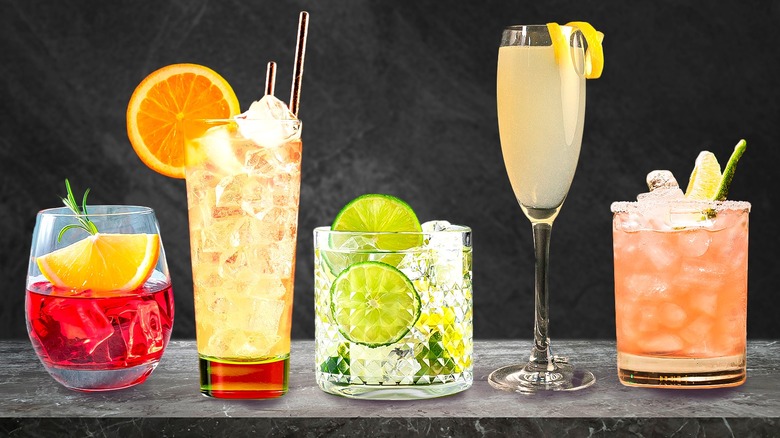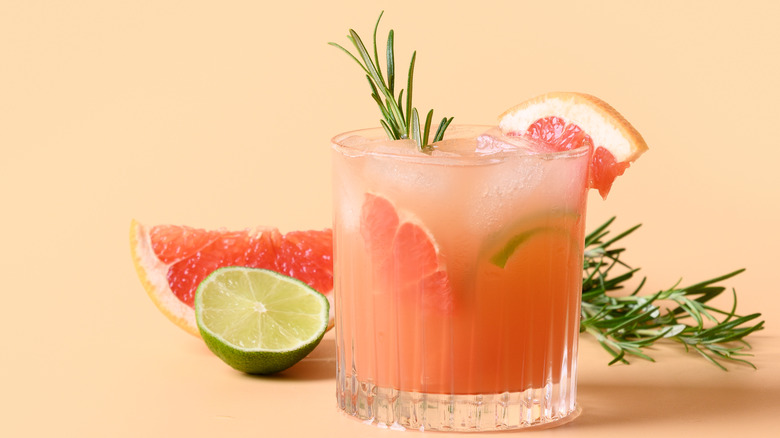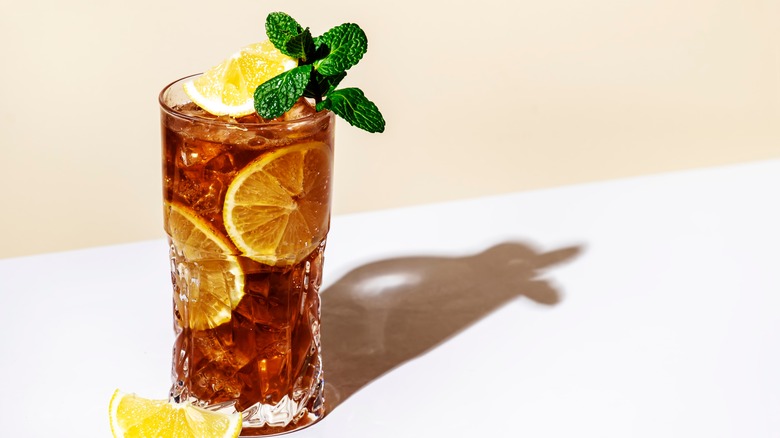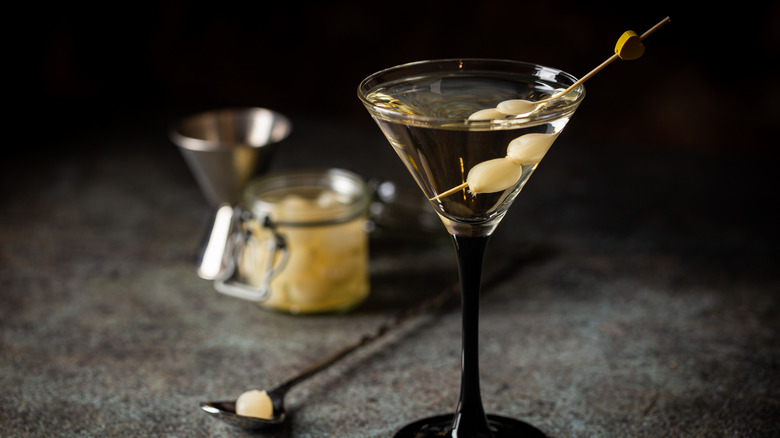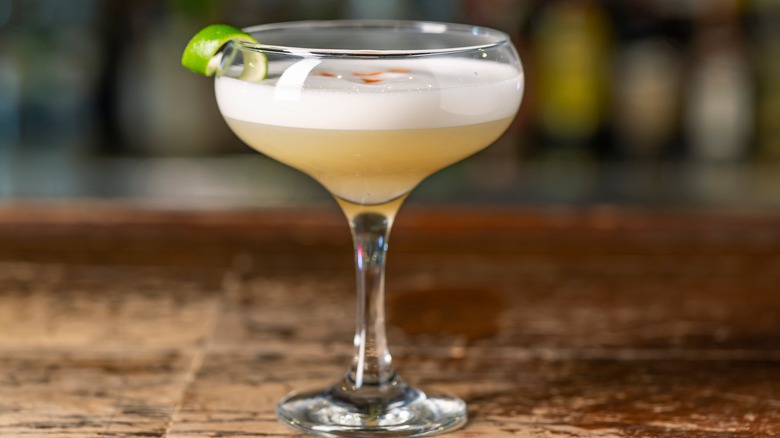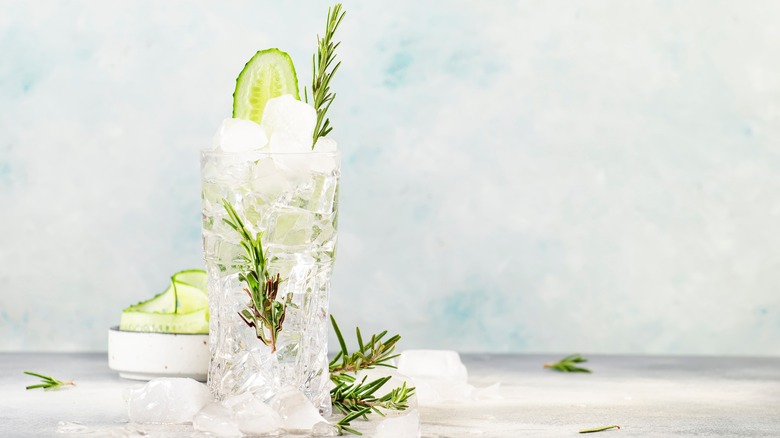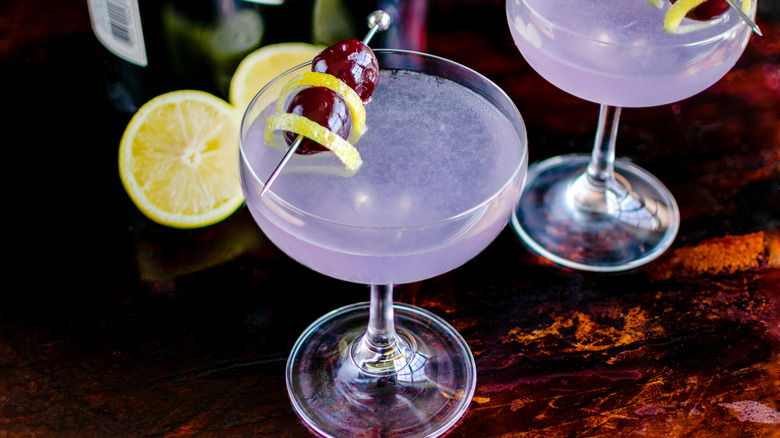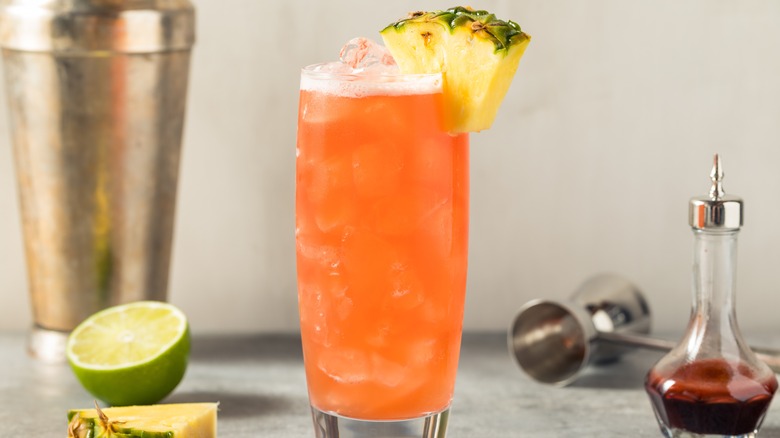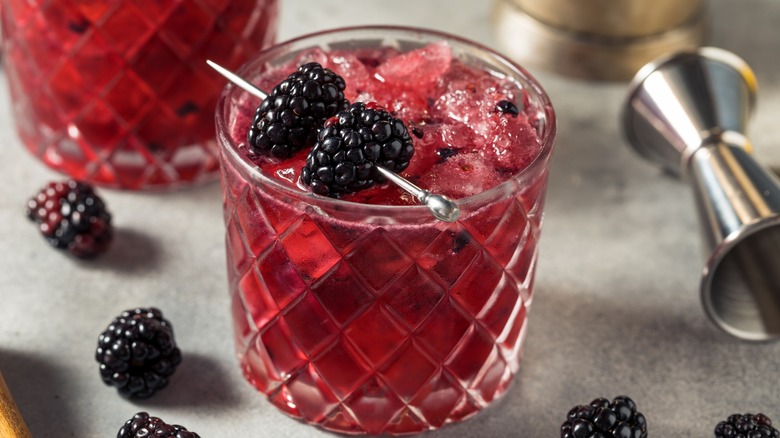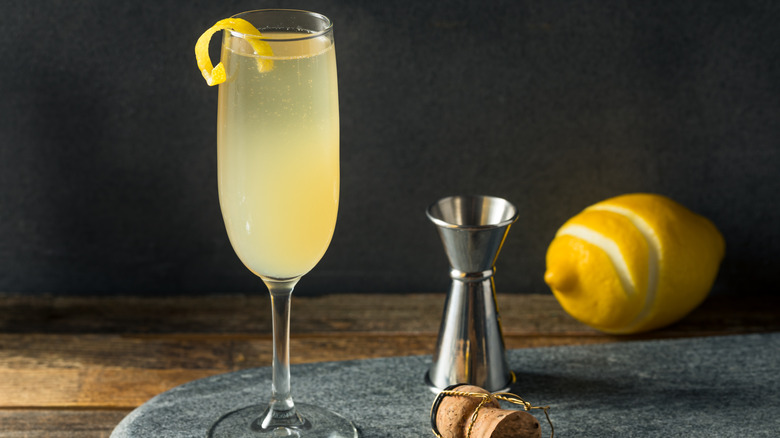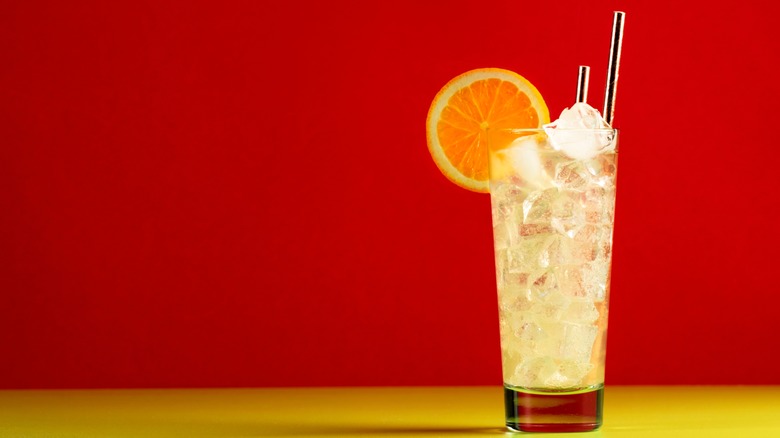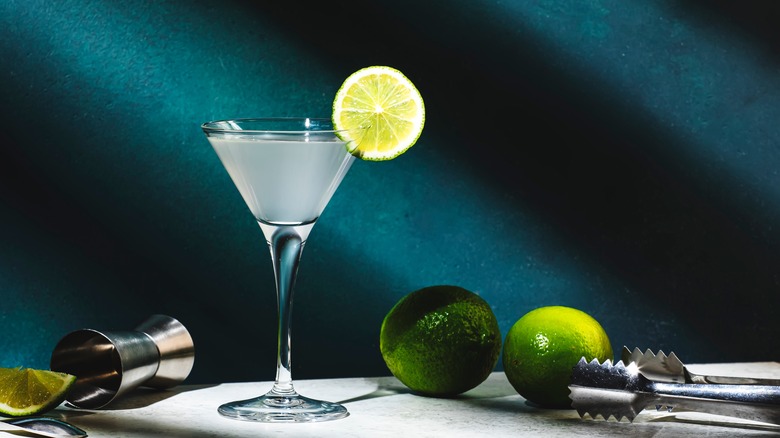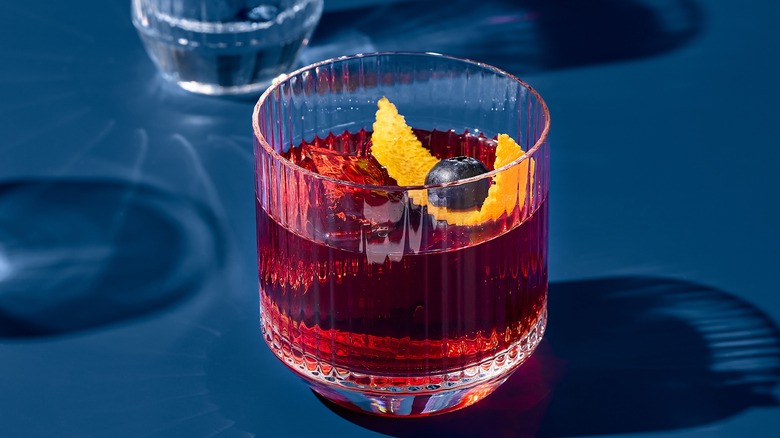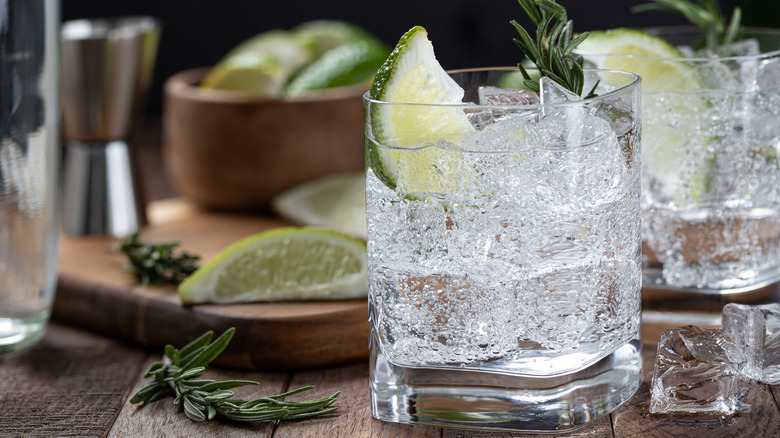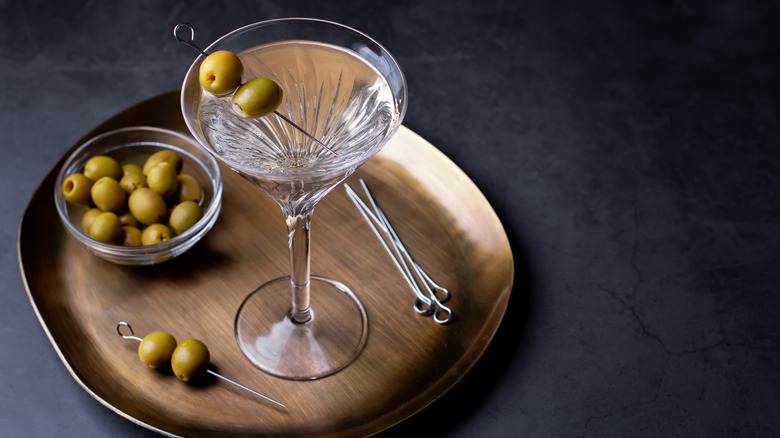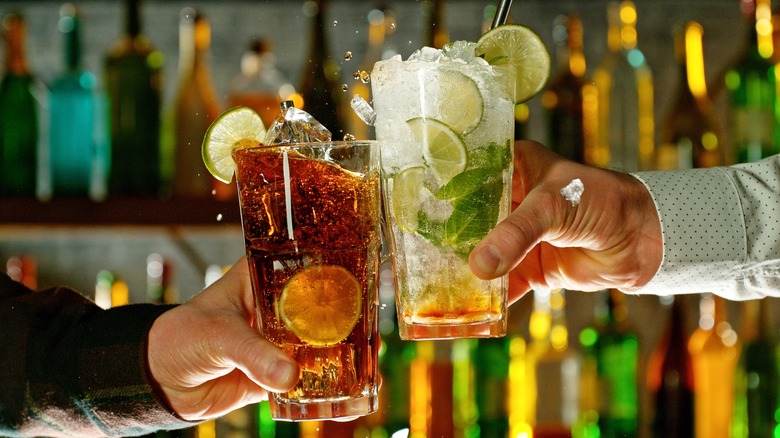14 Gin Cocktails, Ranked Worst To Best
Gin, a deceptively simple spirit, has emerged as a quintessential character in the world of cocktails. The roots of gin trace back to 16th-century Holland, and not to England, as many might surmise, given all the London gin varieties that are available. At first, the concoction was developed for medicinal purposes, but over time, its popularity transcended the apothecary and found its place in a burgeoning cocktail culture. Distilled from grain alcohol and flavored with a unique blend of botanicals, the most predominant being juniper berries, gin boasts a distinctive profile that sets it apart from other spirits.
One of the key reasons gin excels in cocktails is its botanical complexity. Beyond juniper, flavorings such as citrus peel, cucumber, and various spices may be included to boost the spirit's multifaceted taste. This botanical medley imparts depth and nuance, providing mixologists with a versatile foundation to build upon. From the classic gin and tonic, where the effervescence of tonic water complements the botanical notes, to the sophisticated martini, where the spirit's herbal nuances shine alongside vermouth, gin effortlessly adapts to its environs. Moreover, gin's compatibility with fresh herbs, fruits, and other spirits enhances its mixing capabilities. But that is not to say that all gin cocktails are perfect. Indeed, some are better than others, which is why we've endeavored to rank them, from worst to best, based on flavor profile and ease of preparation.
14. Greyhound
The screwdriver, that classic cocktail made with only vodka and orange juice, and the only one college kids seem capable of preparing in earnest, could be given a run for its money with the Greyhound, a mixed drink made with grapefruit juice and vodka or gin. When using gin, this simple drink is instantly upgraded by the addition of the spirit's juniper berry essence, compared to vodka's plain and neutral flavor. At the same time, the grapefruit juice gives the drink added acidity, creating a stronger overall flavor than a regular screwdriver.
But those stronger flavors are also why this drink falls to the bottom of the ranking of best gin cocktails. For those who love grapefruit's unique flavor, all the more power to you. But many are often turned off by it, especially if the juice is not fresh. If this is you, give the drink one more chance with our sweetened Greyhound(ed), which involves fresh ruby red grapefruits, sugar, and vodka, which can be substituted for gin. While the steps are a bit more involved than a regular Greyhound, which just mixes two ingredients, this version will get rid of any discomfort caused by the excessive acidity.
13. Long Island Iced Tea
The Long Island Iced Tea is one of those cocktails that you can drink all night without even noticing you're consuming alcohol — a dangerous thing, which is why it finds its spot toward the bottom of our list. Between the gin, rum, vodka, tequila, and triple sec, this drink is about as high in alcohol content as it gets, but the lemon juice and Coca-Cola do a stellar job at hiding its taste. While any alcoholic beverage should be consumed in moderation, this one deserves special attention.
The Long Island iced tea is typically seen as a delightful summer beverage, but it can be enjoyed all year round, especially in our version, developed by Michelle McGlinn. This one involves a touch of honey, which isn't usual for this drink, but that can help bring out the tea-like quality of the cocktail, even though there is no actual tea involved.
12. Gibson
Martinis come in many shapes and forms, from appletinis to espresso martinis and everything in between. Not to mention the classic style or dirty Martini. On top of all that, there is the Gibson, which is basically a classic Martini made with a different garnish. While the usual dry martini is made with five parts gin to one part dry vermouth and served with a lemon twist, the Gibson is made with the same ingredients, in the same proportions, but garnished with a pickled onion.
That last touch makes all the difference. The umami added by the onion changes the aura of the drink, not to mention the flavor, as if you were dealing with an entirely new beast. That said, we're not going to pull your leg and claim that it is a completely different drink, which it's not, and that's why this cocktail has ended up in 12th place instead of 1st.
11. White Lady
The White Lady is widely believed to have been invented in London in 1919. Initially a combination of crème de menthe, triple sec, and lemon, this version eventually faded away after its inventor altered the recipe in 1929 after moving to Paris. This bigger and better version, which remains de rigueur today, was made with gin, orange liqueur, lemon juice, and egg white — a mixture that seems to provide a more balanced flavor profile than the mostly saccharine original.
Indeed, the combination of gin, orange, and lemon achieves a harmonious balance between the botanicals of the gin and the tangy citrus fruits. The only potential obstacle to a perfect drink is the egg whites, which may present some health problems for some, as they are uncooked. Making this drink at home may also require some extra skill with bar tools, as the egg whites need to be soft and frothy to achieve their intended effect. The trick is to initially shake the egg whites and other ingredients without ice, before adding it in and shaking everything again.
10. Gin fizz
The gin fizz has a history that is as bubbly as its name suggests. Developed in 1888 at the Imperial Cabinet Saloon in New Orleans, the traditional recipe for this cocktail blends gin, lemon, lime, simple syrup, egg white, heavy cream, club soda, and orange flower water in perfect harmony. All together, these elements give this drink sweetness, tartness, and richness — all the best flavors one could find in a cocktail.
In short, the gin fizz might be one of the most beloved gin drinks in America. But there is a catch. The inventor of the drink, Henry Charles Ramos, prepared it with an essential and challenging shaking process, to the point where he had to hire a whole team of strapping young men just to shake the shaker, which as legend has it, they had to do for a full 15 minutes for each drink. Luckily, our Ramos gin fizz recipe only calls for 30 seconds of shaking, and even that seems like a lot when you get down to it.
9. Aviation cocktail
The aviation cocktail, made purple by the inclusion of creme de violette liqueur, is beautiful to look at and even better to taste. This gin drink has enjoyed varying degrees of popularity over the years, but it has nevertheless endured, thanks in part to its wide appeal for gin lovers and those who enjoy sweet cocktails.
Our version of the classic aviation cocktail was developed by Michelle McGlinn, who calls it "gin-forward, but sweetened by the crème de violette and lemon." This careful harmonization cuts through that slightly bitter flavor that some gins can have, making this the perfect drink to prepare no matter which type of gin you have on hand. Meanwhile, the floral accents of the creme de violette join in step with the botanical notes of most gins. Just don't skip the shaking process, as you might normally do for other gin-based drinks. Although shaking gin can sometimes diminish the flavor, the aviation cocktail can also come off too strong without this step. Enjoy this drink all year round, but especially around Easter, when light purples and other pastels fit right in with the ambiance.
8. Singapore Sling
The Singapore sling was invented in Singapore sometime between the late 19th century and the early 20th century and has been filling the glasses of joyful revelers ever since. This combination of sweet and tangy bright flavors helps the gin transform from a gray and dreary London spirit into a tropical party liquor. The version of the Singapore sling put forward by the Daily Meal calls for a cherry liqueur, Cointreau, herby Benedictine liqueur, fresh pineapple juice, lime juice, grenadine, and a dash of Angostura bitters and illustrates this point perfectly.
Aside from the bright and fun flavors, a benefit of preparing this recipe at home is the ease and simplicity of it. All you have to do is pour all the ingredients together in a cocktail shaker with some ice, shake it all up for a good 30 seconds, and then strain the liquid into your glass. It can make any novice cocktail maker feel like a seasoned bartender.
7. Bramble
Let's face it: The 1980s were not a great time for cocktails and mixed drinks. Bartenders across the country opted for the easy way out, favoring premixed formulas to experimenting with fresh ingredients or using any creativity whatsoever. But the Bramble, a gin cocktail created in 1984 at London's Fred's Club, stood out as a beacon of light in an otherwise benighted cocktail scene. This blend of gin, lemon juice, simple syrup, and crème de mûre, a blackberry liqueur is packed with fresh ingredients and bright flavors.
Indeed, the origins of this cocktail couldn't be any fresher. Dick Bradsell, the bartender who invented the cocktail, was inspired by his childhood love for picking wild blackberries. Although the typical recipe calls for blackberry liqueur and not fresh blackberries, you can certainly use one of these as a garnish, and even muddle some in your drink if you want to get serious, especially if you're making the cocktail when the fruit is in season, during the height of summer. Alternatively, you could add some blackberry syrup for an extra intense flavor. As a bonus, this drink is easy to make even for inexperienced bartenders. For an even easier version, try this Bramble On cocktail, made with nothing but gin, lemon juice, and raspberry jam.
6. French 75
When this cocktail was invented in the New York Bar in Paris during World War I, it was said to be so powerful that drinking it felt like being hit with a French 75-millimeter gun, which, at the time, was the French army's most significant weapon. An apt comparison for a cocktail made with plenty of gin as well as Champagne, but what's even more fitting, is that the field gun in question was the first one made that was able to compensate for recoil, and, indeed, the French 75 is as smooth a cocktail as they come.
If you haven't tried this drink yet, it's time to get cracking. Our timeless recipe can be made safely at home and is complete with suggestions for ingredient substitutions and creative garnishes. Indeed, this drink is extremely versatile, meaning you can substitute many of the elements and still call it a French 75. For instance, an elderflower syrup instead of the usual simple syrup can add added floral notes that pair exquisitely with the botanical notes in gin, while no one will fault you for swapping lemons for limes. You can also serve this drink at pretty much any time of day. It makes for a step up from the usual mimosa at brunch, and it can also get your appetite going as an aperitif.
5. Tom Collins
The Tom Collins is one of the most ubiquitous drinks you will find at bars around town, in part because it requires simple ingredients that can be used in a range of other cocktails — namely lemon, soda, simple syrup, and gin — and because pretty much any bartender can whip one up without much of a sweat.
Indeed, even you can make a Tom Collins at home without messing things up, especially if you choose to follow our Meyer lemon Tom Collins recipe, which uses a type of lemon that is sweeter and less acidic than usual. Indeed, this variation yields an even brighter and more refreshing cocktail, making it an ideal choice for leisurely summer afternoons. To add even more sophistication to this recipe, you can drop in a sprig of thyme or rosemary. This may not seem like much, but the herbs help bring out the gin's juniper undertones, further enhancing the flavor of the drink.
4. Gimlet
This classic cocktail — invented in the 19th century and administered to sailors to help stave off scurvy — has persisted through the ages practically unchanged. Our gimlet recipe possesses an essence akin to the historical brews served in naval enclaves of yore. A sip, and you're transported to the era when sailors braved the seas, and various diseases, and risked their lives for queen and country.
To make it, you won't need anything fancy. It is just made of gin and lime juice, with a splash of simple syrup to suit modern palates and make the medicine go down — Mary Poppins wasn't joking about that. Once you have your ingredients, just combine everything into a cocktail shaker with some ice, shake it all up, and strain the result into your glass. Don't forget to garnish it with a lime wedge, just like a proper gimlet of days gone by.
3. Negroni
The Negroni is having a moment right now. It seems to be on the menu at every bar from New York to LA, and literally on the lips of every reveler. There are variations galore, made with different liqueurs, mixers, and garnishes. If we didn't know any better, we'd say the Negroni were a fad, an item that becomes felled by its popularity, destined to sink into oblivion as soon as the next hot thing rolls into town. But we do know better, and we're here to tell you that the Negroni is here to stay. Not just in survival mode, but as one of the best cocktails ever invented. Its popularity today can only be explained by the fact that people are finally catching on, saying, "Where have you been all my life?"
Invented in Florence in 1919, the classic recipe uses gin, red vermouth, Campari, and a bright orange peel. The Campari will make this drink a little on the bitter side, which is why we haven't placed it first on the ranking. But the sweet red vermouth will balance this out while also deepening the bright red color provided by the Campari. Another great benefit of this drink is that it's super easy to make. You don't even need a shaker — just pour everything into a glass with some large ice cubes and stir.
2. Gin and tonic
The gin and tonic is such an enduring, popular drink that we could hardly do without it, which is why it nearly tops the list here. Indeed, British author Douglas Adams said it best in his seminal work, "The Hitchhiker's Guide to the Galaxy," when he said that, "85% of all known worlds in the galaxy ... have invented a drink called jynnan tonnyx, or gee-N'N-T'N-ix, or jinond-o-nicks, or any one of a thousand or more variations on the same phonetic theme."
All we know is that our world would be very sad without gin and tonics in it. To make our especially bold and flavorful version for a gin and tonic, gather gin, large ice cubes, a bright-tasting herb (like lime balm, lemon thyme, or mint), tonic water, and juniper berries. Fill the glass in the appropriate order, stir, and you're done. With this recipe under your belt, you can travel the universe in perfect safety and contentment.
1. Martini
The martini tops our list for more reasons than we have the space to recount here. So let's break it down into two main categories: This drink appeals to more palates than any other drink due to its simplicity and elegance, and it can be molded, taken apart, and reconstituted in an almost infinite number of forms. But first, let's address the gin versus vodka skirmish. Although you may prefer one over the other, which we'll allow, let us make a case for the use of gin, which brings added flavor to simple martinis with its various infusions of juniper berry, fennel, citrus, or cucumber. Vodka, by contrast, is a plain Jane in this department.
Once the gin factor is established, a whole world of Martini cocktails will be open to you. First of all, you can play around with a wide range of gin brands, from Aviation gin with its flowery lavender notes to Hendricks gin, complete with light cucumber flavors. Second, you can make what you will of it. It's practically a blank canvas onto which you can project your wildest fantasies. You could shake up an extra-dry martini with nothing but your favorite gin and some ice, or you could indulge in any of our Martini variations, like our elderflower pear Martini, or this classic lychee Martini, both improved with the use of gin's botanical essence.
Methodology
The items on this list are among the most classic gin cocktails, not taking variations into account. We looked at which of these tend to be the most popular and chose the ranking based on this factor, as well as ingredients (like bitters, which tend to turn some people off due to their strong flavor), and ease of preparation, such as shaking times or working with finicky ingredients like egg whites.
Static Media owns and operates Tasting Table and The Daily Meal.
